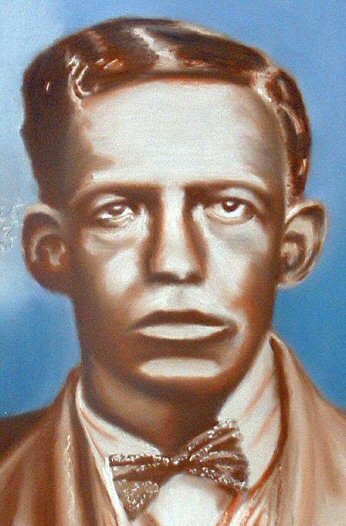
Painting © 2004 Loz
Arkle
Website
© Copyright 2000-2011 Alan White - All
Rights Reserved
Site optimised for Microsoft Internet Explorer
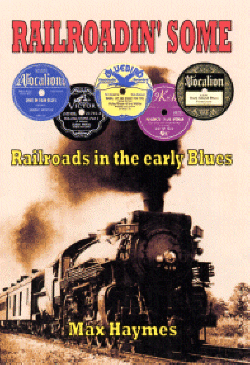
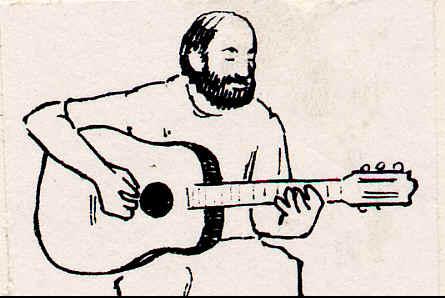

Hoboes,
and their Constant Struggleby Alan White |
|
"When a woman gets
the blues, she goes to her room and hides, (x2)
Freight Train Blues,
Trixie Smith But why a freight train and not a passenger train? Mainly because the average southern Black had little or no money. Even though the majority of blacks would work and save hard for their ticket to travel as a paying passenger there were many who were scared to pay for a ticket: they were the blacks with a criminal record, or on the run with a debt to pay, who knew that their presence at the ticket office would be noticed and instantly reported. For the man in trouble, the railroad was the swiftest method of avoiding capture, and the long distances that the trains covered could enable him to get outside the state, and thereby outside the local arm of the law. His situation was most often desperate, requiring desperate means to escape from his predicament. He had to jump at the opportunity of escape to a better world. He needed to get a free ride, and the best way was to board a freight train. But how did he clamber on board a moving train without being injured, or seen by the railroad men with the certainty of being physically thrown off? The easiest way was to lie in wait on a curve in the line; to jump on board, taking advantage of the slow moving train coming round the bend, and using the bend of the train to hide his movements from the railroad men. Once he had climbed on board, in itself a very dangerous task, he would try and make his way to the 'blinds' if he could. These were the baggage cars next to the tender, which were 'blind' having no end door so the conductor or railroad police could not walk through the train to the first vehicle, behind the locomotive. Hence it was a relatively comfortable safe haven. More dangerous, but out of sight and unreachable by the railroad workers, was to perch on the brake rods that ran beneath the freight cars. Risking his life he might try to worm his way across these, finding a means of balancing precariously there, or he might carry a small board to throw across the rods and then lie on it in the narrow gap between them and the underneath of the rail car. Holding on to axle beams, brake rods, or coupling links throughout day and night, in icy winds, in choking poisonous fumes in the tunnels, he could easily succumb to numbness or exposure and drop to certain death on the track below. To hobo a ride took the determination of the utterly desperate, and took reckless nerve. There was no room for mistakes, no second chance; one slip would mean death or serious injury. However the hobo's tricks and skills of getting free rides and avoiding the railroad workers were handed down to the younger ones, as the experienced hoboes liked to have children with them to help make fires, cook, and beg when they got to the cities. Living dangerously, they continued this way of travelling unless injury forced them to beg their rides from the 'mean old fireman' and the 'cruel old engineer'. However, appealing to the railroad men for a free ride seldom had any effect. Although sometimes hoboes would be charged a ‘fare’ by the conductor/brakeman, etc. Often a dollar for each division (100 miles) travelled, which of course the railroad company would never see in its ledgers. However, the railroad men were usually frightened of loosing their jobs, and the hoboes or 'bums' constituted a major problem to the railroad companies. Very often freight was damaged by hoboes in their search for food and drink. The hoboes were effectively treated like vermin by the railroad workers. Firemen would turn their hoses on the hoboes who clung to the box-cars, so that their wet clothes would freeze to them and they would fall from their perches; brakemen who had clubs to tighten down the brakes would swing them at the tough and desperate hoboes. The railroad workers were equally the traditional enemy of the hobo. The hoboes used terms like: the 'snakes' - the switchmen, whose lapel buttons had an 'S' motif, and the 'stingers' - the brakemen, whose buttons had a 'B' motif. The ranks of the railroad workers were supported by the railroad 'bulls' and 'shack bullies' - special agents employed by the railroad company as 'police' who fought the hoboes, wielding clubs through the hobo encampments. To protect themselves against assaults from the railroad officials and police, the hoboes frequently banded together to ride in groups upon the cars. "Now I could ride the
pullman, but there it is again, Now I could be a doctor,
my duty I never would shirk;
Naw, I Don't Want to be Rich, Carson J. Robison
Special Agent (Railroad
Police Blues), Sleepy John Estes Having reached a district in which they might hope to find work (Chicago was the hobo's Mecca, with an extensive rail network), or where they intended to settle for a while, the hoboes gained strength and protection away from the railroad police by living in 'hobo jungles'. These were encampments on the fringes of main cities, which were safer than the alleys within the cities. They were like our gypsy camps of today; living communities with such 'entertainments' as gambling dens, ladies of the night, and even roadshows. The railroad police often had raids or ‘purges’ in the hobo jungles on orders from the railroad companies. The city police knew of them but left well alone. A hierarchical set-up existed in the jungles and often tasks were rotated in a mutual ‘self-help’ system; searching for food, begging for money, acquiring liquor, sharing plates/utensils, etc. (A good description is to be found in “The Hobo” by Nels Anderson 1927 (rep). U. of Chicago Press. 1st. pub. 1923). "Now when I came in
on the Mae West, I put it down at Chicago Heights, (x2)
Now if you hobo to
Brownsville you better not be peepin' out, (x2)
Hobo Jungle Blues, Sleepy John Estes Hidden deep in wayside brush but well known to the experienced hoboes, the jungles were primitive shack towns made from scrap metal, wood, cardboard, and packing cases. The inhabitants of these jungles, some of whom having made the desease-ridden tips their permanent homes, would scrape together a meagre life. These encampments were also known as 'Hoovervilles', after President Hoover, who was blamed for not injecting money into the poorer areas. How little things change. Even now we still have very similar 'homesteads' in the City of London; homes of our very own tramps! "I'm a broken-hearted
bachelor,
Well jungle, this ole
jungle, cinders blowin' back in my face, (x2)
Old Bachelor Blues, Son Bond "One evening as the sun
went down
The Big Rock Candy Mountain, a famous old hobo poem
"Now listen to her
rumble, now listen to her roar,
The Wabash Cannonball, Galli Sisters The southern Blacks, forced to migrate from their homes out of desperation to seek prosperity in the big cities (their 'Promised Land'), created an American legend: the hobo; the bum; the tramp. Their life was hard. There was no promised land. The cities were as harsh for them as the homes they had left. Prosperity, or even a semblance of a better lifestyle was always beyond their reach. This, more often than not, forced them to keep on travelling, to have almost a permanent presence on the freight trains; to be in constant struggle with the railroad workers. This harsh lifestyle was the inspiration for poignant expression in blues songs. Hobo songs were the impromptu emotions of the man along the track. Their very simplicity and spontaneity indicates they were from the heart, with no aspiration toward culture or learning. Moreover, these songs are peculiarly African American, tracing the black people's struggle with authority in the hopeless quest to find stability in their lives.
Copyright
Ó
Alan White
2011 References: Paul Oliver "Blues Fell This Morning Other Blues Music References: Memphis
Minnie 'Outdoor Blues' __________________________________________________________________________
Website © Copyright 2000-2011 Alan White. All Rights Reserved. |




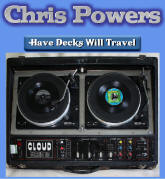
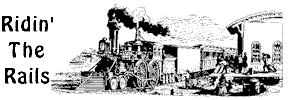 For southern Blacks the appeal
of the railroads has always been both a real and a symbolic one. Way back in
slavery periods, when black slaves were unable to travel between districts
without written 'bonds' from their owners, the sight of powerful locomotives
thundering past, with clouds of black smoke billowing into the air, created an
awe which remains even today. For them the train was a symbol of power, of
freedom and escape. This image carried on, in the hard times of the 1920s and
1930s, when the southern Blacks struggled to make a living and saw the northern
cities as their saviours, where work was plentiful and a better life was to be
had. Again the symbol was of escape, from hard times, from crimes, from broken
hearts. This symbolic importance of the railroad was imprinted on black music.
As the blues developed, the railroad featured prominently in the songs, with a
large number reflecting the life of the hobo; the symbolic had become reality,
with northbound trains carrying innumerable black males (and a few women)
leaving the south.
For southern Blacks the appeal
of the railroads has always been both a real and a symbolic one. Way back in
slavery periods, when black slaves were unable to travel between districts
without written 'bonds' from their owners, the sight of powerful locomotives
thundering past, with clouds of black smoke billowing into the air, created an
awe which remains even today. For them the train was a symbol of power, of
freedom and escape. This image carried on, in the hard times of the 1920s and
1930s, when the southern Blacks struggled to make a living and saw the northern
cities as their saviours, where work was plentiful and a better life was to be
had. Again the symbol was of escape, from hard times, from crimes, from broken
hearts. This symbolic importance of the railroad was imprinted on black music.
As the blues developed, the railroad featured prominently in the songs, with a
large number reflecting the life of the hobo; the symbolic had become reality,
with northbound trains carrying innumerable black males (and a few women)
leaving the south. Of the vast majority of hobo
'transients' who were 'on the bum' during the thirties (estimates ranged from 2
to 4 million) a large proportion were black and only a small percentage of these
were true 'boomers' or migrant workers. Far too many had no prospects whatsoever
and travelled aimlessly, with the city police ready to arrest them for vagrancy,
or the railroad police for failing to pay their fares. Living from day to day,
skipping from one freight train to another as they rattled slowly along,
constantly dodging the watchful eye of the railroad workers, the hobo travelled
from city to city, with hobo jungles as temporary resting places. No purpose to
their journeys; no goal to achieve; no end in sight; a living hell.
Of the vast majority of hobo
'transients' who were 'on the bum' during the thirties (estimates ranged from 2
to 4 million) a large proportion were black and only a small percentage of these
were true 'boomers' or migrant workers. Far too many had no prospects whatsoever
and travelled aimlessly, with the city police ready to arrest them for vagrancy,
or the railroad police for failing to pay their fares. Living from day to day,
skipping from one freight train to another as they rattled slowly along,
constantly dodging the watchful eye of the railroad workers, the hobo travelled
from city to city, with hobo jungles as temporary resting places. No purpose to
their journeys; no goal to achieve; no end in sight; a living hell.